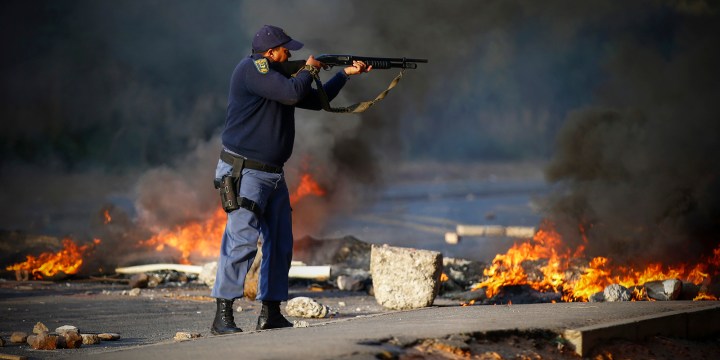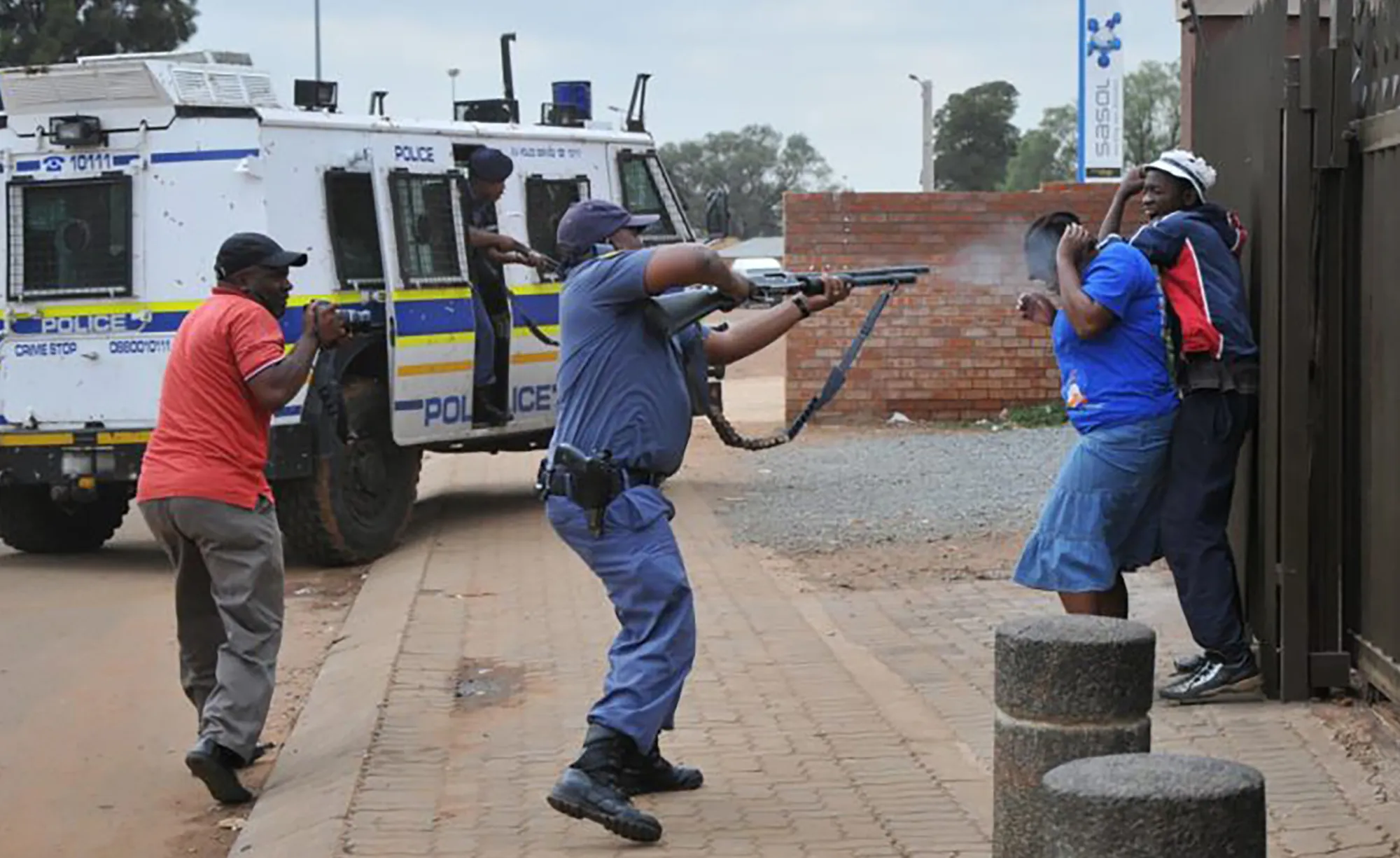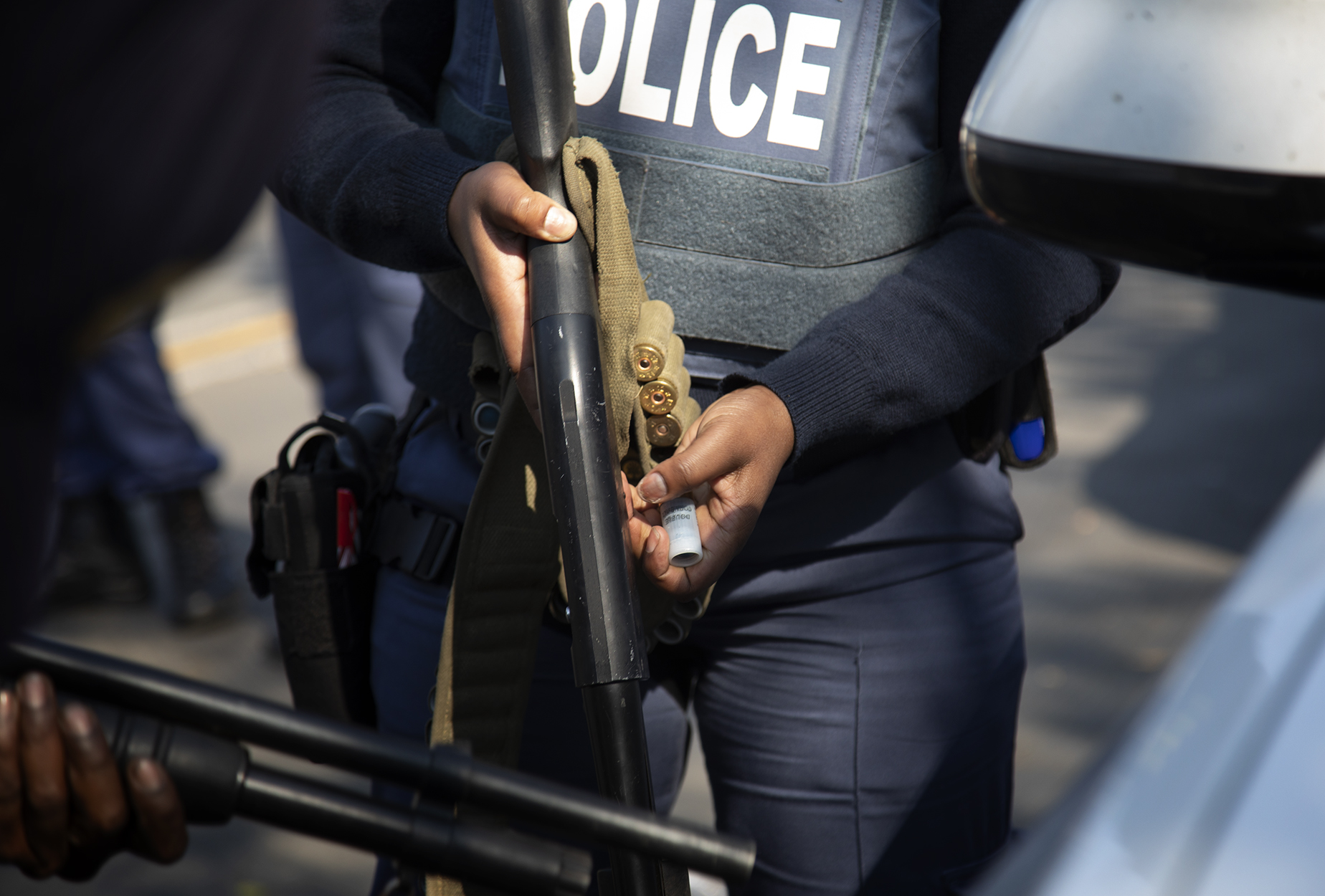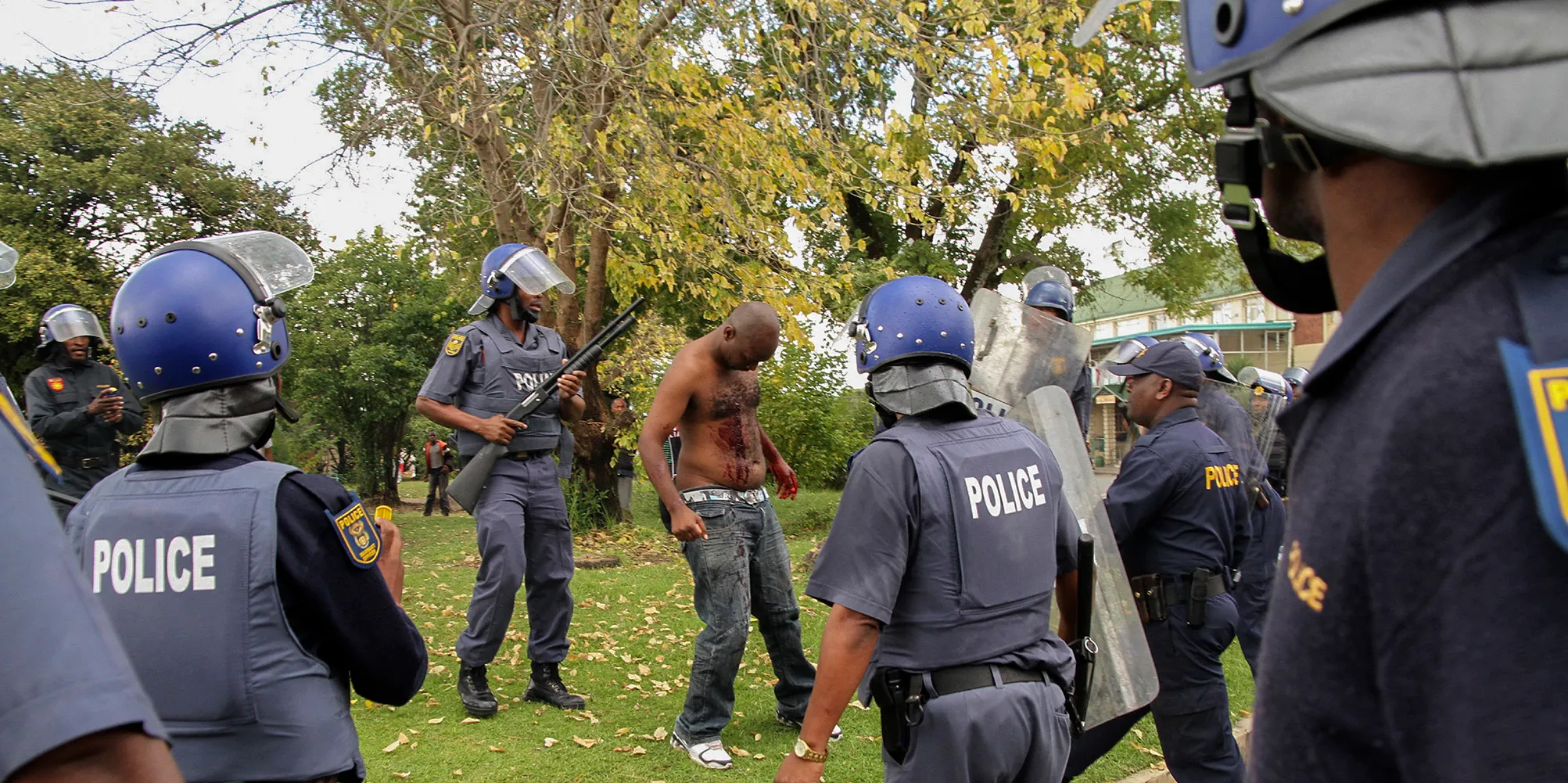POLICING
‘Trigger-happy’ use of rubber bullets by police results in death and lifelong injury in South Africa

The police have a limited repertoire when it comes to responding to unrest. Their modus operandi is to fall back to the use of rubber bullets, often with permanent consequences.
It wasn’t long after the shooting started that the first of the injured came through the doors of the emergency room of the Hillbrow Community Health Centre.
Dr Suhayl Essa was on duty on Sunday, July 12 and while he and his colleagues were trying to make sense of the shooting they could hear outside, he was confronted with his first gunshot victim.
The man, Essa said, told him that he had his eyeball in his jacket pocket. Examining the man’s eye, Essa realised what had happened.
“A rubber bullet had got lodged in his eye, and he pulled that out and he thought it was his eye,” explains Essa.
The doctor was unable to save the man’s eye.
That Sunday, unrest was spreading across Gauteng, triggered by former President Jacob Zuma’s imprisonment. Outside the clinic, police and metro police were trying to stop the looting that had flared in Hillbrow.
Other patients with rubber bullet injuries were also rushed to the clinic. By the end of his shift, Essa believes they had treated between 20 and 30 people with rubber bullet injuries.
One patient was a six-month-old baby that had been struck on the head. The baby was transferred to another hospital and was lucky to survive.
Two of the injured had each lost an eye.
“The patients that came in with severe injuries from rubber bullets were shot at directly and at short range,” says Essa. “It is like some police were using it as target practice.”

File Photo: Police fire rubber bullets at residents at point blank range, 13 March 2014, in Bekkersdal, Westonaria. (Photo: Alaister Russell / The Citizen)
The injuries were caused by what has become the SAPS and Metro police’s go-to weapon when quashing violent protests.
The rubber bullet, as it is called in South Africa, is better known elsewhere as a kinetic impact projectile. When fired from a shotgun, two rubber pellets are expelled when the trigger is pulled. Over the past decade, these projectiles have continued to be controversial.
They have killed and maimed, yet police remain unwilling to give them up. In the aftermath of the recent widespread unrest in Gauteng and KwaZulu-Natal, it appears that rubber bullets have once again caused serious injury and death.
On Monday, 13 July, a 15-year-old boy died after he was allegedly hit by a rubber bullet during unrest at Southgate Spar in Pietermaritzburg.
“We do have cases that are under investigation, but at the moment I can’t tell you how many there are,” says Grace Langa, the spokesperson for the Independent Police Investigative Directorate — South Africa’s police watchdog organisation.
Globally and in South Africa there are growing calls to ban the weapon.
In March, the EFF said it wanted rubber bullets abolished after they were used in the close-range killing of Mthokozisi Ntumba, a bystander who was caught in the crossfire of a student protest in Braamfontein.
In 2019 Chile was in the process of introducing a law that prohibited law enforcement officials from using cartridges that contained multi balls, like those used in South Africa. The reason for this was the high number of eye injuries they caused.
The UK hasn’t used them since the 1970s.
Thato Masiangoako, a researcher at the Socio-Economic Rights Institute, and Dr Mary Rayner, a research associate at the University of London recently published a paper titled “A Double Harm: Police misuse of force and barriers to necessary Health Care Services”. It examined the police’s response to student protests at Wits University between September and November 2016.

A SAPS member loads rubber bullets outside the Pietermaritzburg High Court on Tuesday 6 July 2021 as pro-Zuma supporters flout Covid-19 regulations. (Photo: Leila Dougan)
“From that research, I think our position on rubber bullets has been crystallised in terms of just how dangerous the weapon is,” says Masiangoako.
Adding to this problem, believes David Bruce — an independent researcher working on policing, crime and criminal justice — is that the SAPS and Metro Police have not been properly trained in crowd control and have a reputation of being trigger happy when using rubber rounds.
“The police have a limited repertoire when it comes to responding to unrest. Their modus operandi is to fall back to using rubber bullets,” Bruce explains.
According to the police’s National Instruction 4 of 2014 on Public Order Police: Crowd Management during Public Gatherings and Demonstrations, efforts should be made to de-escalate any potentially violent confrontation. Warnings also need to be given before the use of force and rubber bullets should be used only “under extreme circumstances”.
In March, National Police Commissioner Khehla Sitole said during a press conference that it would be “impossible to stop the use of rubber bullets”. However, he did say that the police would change standard operating procedures when it came to using the weapon. The police were unable to provide an update of when these procedures would be changed and implemented.

Andries Tatane after he had been shot by the police with rubber bullets in Ficksburg, South Africa on 13 April 2011 where service delivery protests turned violent. Tatane died on the way to the hospital. (Photo: Gallo Images / Beeld / Willem van der Berg)
The problem, says Rayner, is that as a ballistics expert pointed out in her report, the two rubber rounds are inaccurate when targeting an individual.
“So you’ve got a weapon that you cannot aim at a real threat, it is an indiscriminate weapon. And an indiscriminate weapon is unlawful under international human rights law,” says Rayner. “It doesn’t matter how well trained you are when you point that gun, you do not know who’s going to get hit.”
In the panel of experts report that provided recommendations to better policing after the Marikana Commission of Inquiry in 2012, the use of Safe Impact Rounds (SIRs) was suggested for violent crowd control situations. SIRs are single-shot projectiles that are made from foam.
But even if police changed operating procedures and set a distance where it was deemed safe to use the weapon, Rayner stresses that this is not enough. At a distance, they can still cause life-changing injuries.
Witness 21, as he was identified in the A Double Harm report, was on his way home in Braamfontein when he was hit in the eye by a rubber bullet that had been fired from a long distance and possibly had ricocheted off something.
“He had stopped and turned back to where he’d come from and looked towards where the police vehicles were. And then he got hit in his right eye,” says Rayner.
Witness 21 woke up in hospital to be told that they had had to remove his eye.
“I remember sitting with him, and he was in tears because he said his ability to do bits and pieces of work to make up a living had been destroyed,” says Rayner. DM

















 Become an Insider
Become an Insider
Has the trigger happiness increased year after year.Then it shows training has become sloppy,instructors don’t adhere in getting training done properly.Crowd control is done by operational command , with platoon commanders and section commanders.Then they aren’t controlling their manpower.Why don’t you give them Tom and Jerry cork guns.
To pass competency with a shotgun you have to hit a target at 5 meters at least 7 out of 10 times, most guys used to get 10 out of 10 in my time,wonder what happened in the last couple of years???So much for not being accurate according to your research.Unless they pass people who are not competent?
Interesting I rarely see tear gas used. In the case of the looting I’m sure that would have had a greater deterrent than a couple of rubber bullets.
Teargas is banned,due to complaints,I stand under correction, but it was banned round about 2005, due to it being “chemical warfare” that was we were told anyway.We then got training in pepper spray,which is still used today.Interestingly I see our neighboring states using it without any criticism from our goverment.Maybe they sold the excess stock to them.Retired end of 2018. Fed up with the endemic corruption.You are targeted when you fight corruption, ask me
During the July looting I witnessed how a couple of rubber bullets saved the day when hundreds of looters were on their way to plunder two adjacent shopping malls where shoppers were going about their chores inside unaware of the threat outside.
In this instance the SAPS members knew what they had to do to protect lives and property. I had the impression they were well trained and did what they had to do. No-one was injured and the violent crowd dispersed.
To those who say that this type of weapon must be banned please go and stand in front of such an angry and criminally minded mob with no weapon at all. If you don’t want to run the risk of an injury under these circumstances, don’t join thse crowds.
Please excuse me for not having empathy. Our family have a favourite saying – ” Those looking for trouble are never disappointed…” (we use less PC language) The damage of rubber bullets unfortunately did not have enough impact. It is nothing compared to the special-level-stupidity that caused the majority of deaths in the July looting. Not to mention the current burden on the health system for fractured and broken arms and legs, and other self inflicted injuries that are being treated at the moment. This harm should be an indicator the lengths looters were WILLING to face during their ILLEGAL activities.
Shaun, your article does not offer any solution here? It stands to reason that our security forces can’t stand strong against militant, malicious delinquents with a feather duster.
Do you have any constructive suggestions? Police possibly have the most thankless job in the country under the most difficult circumstances. Please put your mind to helping them rather than making their lives even harder that it already is…
looting and burning has a more direct correlation than whether the police are trigger-happy.
Don’t want to get shot at? It’s very easy
That it is necessary at all is the heartbreak.
It is simply a consequence of poverty and ignorance, which only education will solve, which requires people first to be fed.
The real problem – again – is the ANC’s complete failure to date.
The solution: fix the ANC (go Cyril – no alternative I see here), or kick it out and replace it with a better alternative (go DA – or some equal or better alternative)